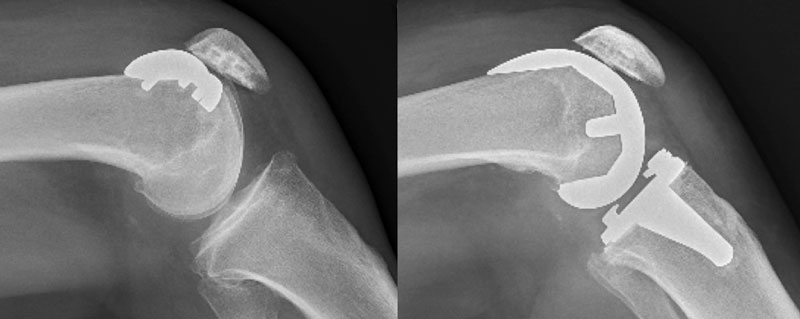Patello-femoral Replacement Surgery.
Where the knee-cap rubs against the front of the femur, a small category of patients develop arthritis, and require a knee replacement. Some of these are suitable for partial replacement of the patello-femoral joint (PFJ).
Roughly 9% of knee replacements are partial (unicompartmental) replacements. Of these, 6% of partial replacements are patellofemoral. The advantage has been demonstrated in a recent presentation at the 2017 American Association of Orthopaedic Surgeons. In a randomised study of 100 patients suitable for PFJ replacement, 50 had a PFJ replacement, and 50 had a total knee replacement (TKR). At six weeks post-operatively, 93% of the PFJ replacement patients felt their knee was improved. In contrast, 46% of the TKR’s felt their knee had improved. The knees continued to improve out to two years, and all time periods, the partial knee replacements achieved better range of movement (130 degrees at 2 years vs 123 degrees), and the patient knee score (OKS) was better.

The images of PFJ replacement and TKR are shown from side on. The PFJ replacement retains to weight bearing surface of the femur & tibia, the cartilages, and the cruciate ligaments. The TKR replaces all surfaces, removes the menisci, and the anterior cruciate ligament.
It is important to note that the Australian National Joint Replacement Registry demonstrates that, over time, PFJ replacements fail. Having said this, the obvious group for PFJ replacement is the elderly. It seems that in the late 70’s or early 80’s, people get to a tipping point that they no longer have the strength to work against an arthritic patella. They may experience difficulty getting in & out of a chair, and unexpected falls start to occur. The knee can be painful at rest.
The challenge is finding a perfect candidate for PFJ replacement. Typically the patients are either elderly (anticipating that the PFJ replacement will be the only operation required), or relatively young (hoping to avoid TKR as long as possible). Patellar tracking needs to be well aligned, or corrected at the time of surgery, and the patient needs to be relatively thin. If another compartment becomes arthritic, it is theoretically possible to do a partial replacement of that compartment, but the world number of cases is so small, it is hard to be clear about the outcome.
AOA NJRR figures 2016 (Data period 1/9/99 – 31/12/2015)*
Patellofemoral replacements 2 931
Medial or lateral replacement 46 094
Total knee replacement 494 571
* All joint replacements in Australia are entered into a central registry.
AOA NJRR figures 2016 (Data period 1/9/99 – 31/12/2015)
Revision operation for partial knee replacement *
Total knee replacement 438
Patella only 50
Medial or lateral replacement 5
* It is possible that a medial or lateral replacement could be recorded as a primary procedure rather than revision, and the numbers higher.
References:
Ordgaard et al, AAOS 2017, Patellofemoral arthroplasty vs TKA of patellofemoral osteoarthritis.
Australian Orthopaedic Association National Joint Replacement Registry.

